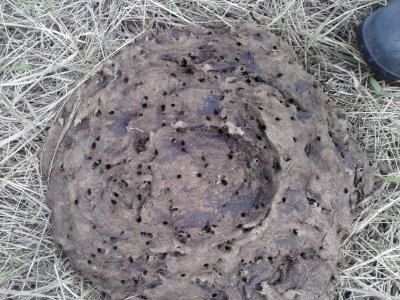SDSU researchers to assess how use of parasiticides in livestock may be affecting populations of dung beetles.
January 26, 2018

The same products that get rid of internal parasites in livestock may adversely affect the dung beetles that help break down dung, according to South Dakota State University (SDSU) assistant professor Lora Perkins in the department of natural resource management. That could be bad news for the dung beetles and livestock production.
Through a four-year U.S. Department of Agriculture grant, Perkins and three SDSU colleagues will examine how producers’ use of parasiticides to control parasites has changed and how that has affected the dung beetle population, soil quality and forage production. The National Institute of Food & Agriculture funding is part of the Bioenergy, Natural Resources & Environment Program, which focuses on the environmental sustainability of rangeland livestock production.
“Dung beetles are little drivers of ecosystem function,” Perkins said. “They turn a big pile of dung into nutrients in the soil that can be taken up again by plants.”
Previous SDSU research looked at the biodiversity of dung beetles and other insects that populate dung pats. “We’re adding onto that research and moving it all the way through to forage production,” she explained.
Perkins, along with assistant professor A. Joshua Leffler and professor Paul J. Johnson, an entomologist, will examine areas at the Ft. Pierre National Grasslands that are used by different livestock producers. Some producers use parasiticides to control parasites, while others don’t.
“By conducting our research at Ft. Pierre, we are able to study areas that are adjacent to one another so the environmental variation among study areas is minimal,” Perkins explained.
The researchers will measure the dung beetle population and examine how rapidly the dung is incorporated into the soil. They will measure nitrogen in the soil and plant production by weighing the biomass.
“Nitrogen availability is a key factor limiting forage production, and dung beetles are key organism in making nitrogen available to plants,” Leffler explained. One doctoral student will also work on this portion of the project, with fieldwork beginning this summer.
A unique aspect of this project is collaboration with assistant sociology professor Jessica Ulrich-Schad. She will survey approximately 2,500 livestock producers to see whether they use parasiticides to control parasites in their livestock or not, whether that has changed over time and why. She will also ask how the parasiticides they are using have changed and what led to those changes. One doctoral student will work with Ulrich-Schad.
“We want to understand the drivers behind the use of these products,” said Ulrich-Schad, who began exploring producer decision-making as a postdoctoral researcher at Purdue University. “We must get a better grasp of how farmers are making these decisions to know how we can encourage them to voluntarily use practices that are good for soil and water quality.”
Through the survey, she will examine producers’ awareness of how these parasiticides can affect dung beetle populations, soil quality and forage production, as well as the roles social networks play in the practices they use and the awareness they have. Preliminary interviews with seven producers she characterized as innovators revealed that some are noticing a decrease in dung beetle populations.
“When dung piles accumulate, fields become ‘fouled’; livestock won’t eat by the pile,” Perkins explained. “We need the beetles to help break down the dung and keep the nutrients flowing and the plants growing.”
Research at other universities also shows that the presence of dung beetles can reduce the survival of parasite larvae in the dung pats.
You May Also Like



